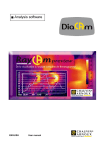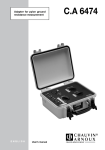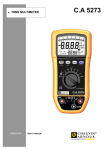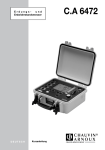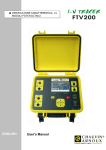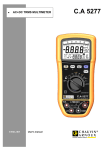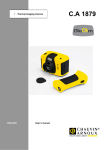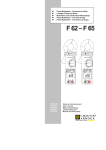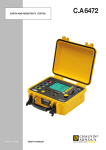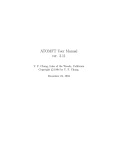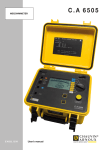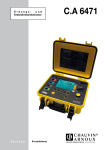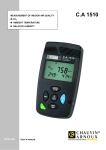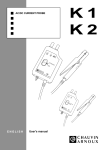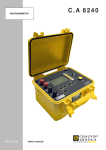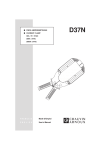Download NF A5 modèle - Chauvin Arnoux
Transcript
Earth and resistivity tester ENGLISH Overview C.A 6472 Introduction This is an overview of the complete C.A 6472 user manual which enables the user to easily find: The rules for using the instrument, The operation of keys and measurement setting configuration, The general configuration of the instrument, The meaning of alarm indicators, The meaning of the various error codes, A glossary lists the terms and abbreviations used on the instrument and the digital display. Rules for use WARNING - risk of DANGER! Read the user’s manual. In these operating instructions, failure to follow or carry out instructions preceded by this symbol may result in personal injury or damage to the device and the installations. Instrument fully protected by double insulation or reinforced insulation. The rubbish bin with a line through it means that in the European Union, the product must undergo selective disposal for the recycling of electric and electronic material, in compliance with Directive WEEE 2002/96/EC. Earth terminal. Definition of measurement categories Measurement category IV corresponds to measurements taken at the source of low-voltage installations. Measurement category III corresponds to measurements on building installations. Measurement category II corresponds to measurements taken on circuits directly connected to low-voltage installations. Measurement category I corresponds to measurements taken on circuits not directly connected to the network. Thank you for purchasing a C.A 6472 earth and resistivity tester. To obtain the best service from your unit: read these operating instructions carefully, comply with the precautions for use, that is to say, temperature, humidity, altitude, degree of pollution and site of use. 1. Characteristics label Stick one of the 5 characteristics labels supplied,in the appropriate language, inside the instrument lid. 2. Instrument functions The instrument is designed and made for the verification and measurement of the various electrical parameters of earthing installations. As an instrument powered by 8 x 1.2 V rechargeable internal batteries, with a maximum voltage output of 16 V or 32 V, as required, the tester is not dangerous for the user. The instrument meets the safety criteria of standards IEC 61010-1, 61010-2-31&32 and IEC 61557, parts 1, 4 and 5 subject to the following conditions: Maximum altitude for use: 3,000 m Use: indoor or outdoor 50 V Max. voltage relative to earth: Installation category: IV Pollution level: 2 Maximum differential voltage at inputs : 75 Vrms Maximum short-term voltage: 250 Vrms (on any 2 of the 4 inputs) The tester also meets standards IEC 60479-1, -2 and –3 and IEC 61326-1. Between the H and E inputs, the instrument is protected by a 0.63 A, 250 V, 5 x 20 mm fast fuse with high 1.5 kA cutout power. warning symbol appears and flashes on the top If voltages over 42 V are present on inputs, the left of the display. 3 - Precautions for use This measuring instrument should be used by personnel trained in the functions of the instrument, as well as in the safety rules and standards applicable to its use. This rule also applies to the use of accessories made by other manufacturers. If there is a suspicion that use of the appliance may be dangerous for the operator, the instrument must be taken out of service, making accidental use impossible. This is particularly true if the instrument: Shows visible sign of deterioration, Does not work properly, Has been exposed to climatic conditions not within specifications, Has been subjected to significant mechanical stress. For safety reasons, Only use accessories, the overvoltage category and assigned voltage of which are at least equal to or higher than those of the instrument (EN 61010-2-031 and 32). Only use the mains adapter unit supplied with the instrument to recharge the battery; this is adapted to charging conditions and meets overvoltage category II requirements ensuring the user's safety from an electrical standpoint. To obtain the best use from your battery and prolong its efficiency: Only charge the instrument between 0° and +40°C. Comply with the conditions for use defined in the user manual. Comply with the conditions for storage defined in the user manual. Do not use the instrument if its accessories appear damaged. Apart from the applications specified, never measure resistance on a powered-up circuit or with a link to the electricity network maintained. Never exceed the protection limits indicated in the specifications. In general, boots, gloves and insulated mats should be used. The equipotentiality of the various locations of the stakes used to measure the earth may be compromised if there are major faults on nearby electrical installations or in certain meteorological conditions (stormy weather). It is up to the operator to judge whether to continue with or postpone a measurement campaign for each situation. Using a specific power unit, the C.A 6472 can also be recharged from a 12 VDC socket in a vehicle. In this case, the low point of the vehicle 12 VDC socket is located at the potential of the E and ES inputs of the instruments. For safety reasons, the instrument must not be used or connected to this power supply unit if the presence of voltage in excess of 32V is suspected on these inputs. 4. Maintenance For maintenance, use only the specified spare parts. The manufacturer cannot accept any responsibility for accidents occurring following repairs carried out outside its after-sales department or approved maintenance network. Changing the battery: The battery for this instrument is specific: it contains precisely adapted protection and safety elements. Failure to replace the battery with the specified model may lead to material damage and bodily injury due to explosion or fire. To ensure continued safety, only replace the battery with the original model defined in the user manual. If the battery is changed, the following safety instructions must be adhered to: Never short-circuit the positive and negative poles. Never dismantle the battery and its cells. Never incinerate or expose to heat sources. Never clean with water or corrosive agents. Never use the battery if it shows signs of leakage or mechanical deterioration. Collect used batteries for recycling within the framework of protection of the environment. To ensure continued safety, only replace a faulty fuse by a fuse with characteristics that are strictly identical to those defined in the user manual. Operating principle The device has 2 operating modes: Automatic mode for routine applications, Manual/Expert mode in which the user can change the parameters of the measurement functions. 1. Automatic mode Set the switch to the desired function, Make the connections appropriate to the function, Press the START button. The device makes the measurement and stops automatically. Read the measurement result on the display unit and the relevant parameters using the DISPLAY key. You can record all of this information in the internal memory of the device. 2. Manual or expert mode Set the switch to the desired function, Make the connections appropriate to the function, Select “MANUAL” mode. Choose the various measurement parameters using the CONFIG key. Press the START button. The measurement frequency or the direction of the current (resistance measurement) can be changed during the measurement to view their impact upon the measurement and the parameters relevant to the measurement can be viewed using the DISPLAY key. When the measurement results are acceptable, stop the measurement by pressing the STOP button. View the result on the display and toggle through the relevant parameters using the DISPLAY key. You can save all of this information to the internal memory of the device. Functions of keys The primary functions of keys are indicated above the keys in white. The secondary key functions (indicated in yellow italics beneath them) are accessible by pressing then releasing the yellow key then the relevant key. The same operation is used to return to the primary function. 2nd CONFIG/ FREQUENCY Activation /deactivation of the secondary key function. The symbol 2nd is displayed on the screen. Setting measurement parameters before measuring: mΩ AUTO – 2 wire/4 wire measurement MANU – 2 wire/4 wire measurement – measurement current flow direction 3 poles AUTO – UOUT MANU – UOUT – measuring frequency – coupling (EARTH COUPLING) SWEEP and OBJ./TEST – UOUT 4 poles AmpFLEX ρ V pot. 2 clamps AUTO – UOUT MANU – UOUT – measuring frequency SWEEP and OBJ./TEST – UOUT AUTO – measuring method - UOUT MANU – measuring method – UOUT – measuring frequency AUTO MANU - measuring frequency Setting measurement parameters during manuel mode measurement: All functions except mΩ : measuring frequency mΩ: measurement current flow direction DISTANCE DISPLAY SMOOTH MEM MR Only when measuring ground resistivity (ρ) and potential (V pot.), programming distances A and/or d, before or after measurement. Display of the various screens and results available in roll mode. Exit of the memory function without recording. Activation / deactivation of the smoothing of measurement display. Memorisation of a measurement and all the information relating to an address defined by an object number (OBJ.) and test number (TEST). An index for the following functions is automatically associated with the test number: 1, 2, 3, 4 for coupling measurements (EARTH COUPLING). DISTANCE for resistivity (ρ) and ground potential measurements (V pot.) FREQUENCY for measurements carried out in SWEEP mode. MEM needs to be pressed twice: 1st press: confirmation of the memorisation address (can be changed with the and keys). 2nd press: memorisation at the chosen address Reading of the values memorised. The address (OBJ./TEST) and, as applicable, the associated index, are selected with the and keys. All the information linked to the recalled measurement can be displayed with the DISPLAY key. Selects the parameter to be modified (in roll mode, from left to right). The modifiable parameter flashes. Incrementation in roll mode of the value of the flashing parameter selected. Decrementation in roll mode of the value of the flashing parameter selected. Operating modes The instrument has 3 measurement modes: AUTO mode: Measurement is activated by pressing the START/STOP key and measurement frequency selection is automatic. Measurement stops as soon as the results are available on the display. MANUEL mode: Measurement is activated by the START/STOP key and stopped by pressing the START/STOP key again. The operator can modify measurement frequency during measurement without it being stopped. SWEEP mode: The measurement sequence is activated by pressing the START/STOP key. The instrument then carries out "n" measurements automatically, corresponding to a sweep in a sequence of "n" measuring frequencies. These "n" measuring frequencies are defined inside the instrument and can be modified via the application software for this instrument. The measuring frequency stops automatically once the " nth" measurement has been carried out. All the measurements in a sequence are automatically memorised at the OBJ./TEST address proposed or chosen after selection of the SWEEP mode. SET-UP MODE Modifiable parameters Command keys Values possible Default value DISPLAY (1 press) m (metres) or ft (feet) m mΩ alarm measure (2 wires) DISPLAY (2nd press) ON / OFF direction ( > or < ) value (1…999 Ω) OFF > 2 Ω Buzzer DISPLAY (3rd press) ON / OFF ON Modbus address DISPLAY (4th press) 1…247 1 Date CONFIG (1 press) yyyy.mm.dd current date Time CONFIG (2nd press) hh.mn current time Communication speed (Bauds) CONFIG (3rd press) 9.6k / 19.2k / 38.4k 38.4k Configuration by default CONFIG (4th press) Yes / no Yes MEM xxx out of 512 (total possible number of locations) - Distances unit Memory occupied st st Verification and adjustment of AmpFLEX via the C.A 6474: accessible on the 5th press on the CONFIG key. Please refer to the C.A 6472 user manual for the procedure to be followed. Display of the instrument serial number and software version: Hold down the CONFIG key while turning the rotary switch on the "SET-UP" position. Viewing all the display segments: Hold down the DISPLAY key while turning the rotary switch on the "SETUP" position. Indicators of limits of use After the measurement has started there are indicators of when: The values RH and/or RS are too high The measurement current IH-E, IES or ISEL is too low Measurement instability is high Those conditions that may give uncertain results are indicated on the display of the unit as follows: Frequency f > 513 Hz f ≤ 513 Hz f > 513 Hz f ≤ 513 Hz Functions 3P, 4P, Vpot. Triggering threshold Indication on the display IH-E < 6 mA 4Psel, AmpFLEX IH-E’ < 6 mA (1) 3P, 4P, r, Vpot flashes (3) IH-E < 1 mA 4Psel, AmpFLEX IH-E’ < 1 mA H All (except r and RS > 5 kW 2 clamps) All RS > 30 kW 4P sel IES < 1 mA flashes (1) flashes (3) S flashes flashes (3) flashes flashes (3) AmpFLEX All ISEL < 10 mA flashes Values measured (U, I, R) unstable, varying by more than 5% of their average value. (2) RPASS IES < 3 mA ISEL < 30 mA US-ES < 10 mV RPASS IES < 0.3 mA ISEL < 3 mA US-ES < 1 mV fixed (3) < > flashes < > flashes -.--- (not defined) All US-ES, US-E, UH-E > 42 V All Spurious voltage of which the frequency and/or value is likely to interfere with the measurement. flashes (3) NOISE (4) (1) (2) IH-E’ : current IH-E measured on startup of measurement before IES or ISEL Not active if the SMOOTH function is selected. (3) may also appear if there is an external voltage > 42 V on the terminals of the The symbol device. You should change to manual mode and modify the measurement voltage and/or frequency to make a valid measurement (when the NOISE symbol is no longer illuminated). (4) List of coded errors On initial operation, the C.A 6472 automatically runs a self-diagnosis. If a fault appears during selfdiagnosis or measurement, the instrument displays a message in the format Err XX. These errors are classified into 3 categories: Not serious Errors 6, 7, 11 and 17 The message is displayed for around 1 second to inform the user. Envisage repair if the error recurs. Recoverable Errors 5, 9, 14, 15, 18, 19, 30, 31, 32 and 33 The error concerns the measurement function in process and disappears if the function is changed. The instrument can therefore be used but will need to be repaired if the error persists. Special cases: An 18 error indicates it is impossible to recharge the internal battery of the instrument. If an 18 error is declared while the battery is being recharged and remains present once the instrument has been started again, stop recharging and replace the battery. In the event of a 19 error, erasing the instrument memory may remove this error. For errors 31, 32 and 33, excessively high voltage or current appeared during measurement. Check the measurement circuit. Fatal Errors 0, 1, 2, 3, 8, 12, 13, 15, 16, 18 (when recharging batteries) and 21 These errors stop the instrument from working. Stop the instrument and start it again. If the error persists, the instrument needs to be repaired. Glossary This glossary lists the terms and abbreviations used on the device and its digital display unit. 3 poles: earth resistance measurement with 2 auxiliary electrodes (3P). 4 poles: 4-wire measurement of low earth resistance using 2 auxiliary electrodes (4P). AmpFLEX: selective earth measurement using the C.A 6474 accessory and AmpFLEX current sensors. C1: coupling coefficient of earth RA with earth Rb (C1= RC/R1 ). C2: coupling coefficient of earth Rb with earth RA (C2= RC/R2 ). d, A: distances to be programmed for the resistivity calculation depending on the measurement method used. mΩ: low resistance/continuity measurement. E: terminal E (earth electrode, measurement current return terminal) EARTH: earth measurement (3-pole or 4-pole). EARTH COUPLING:measurement of coupling between 2 earth electrodes. ES: terminal ES (acquisition of reference potential for the 4P earth resistance calculation). H: terminal H (measurement current injection terminal). I-Act (1): external current presently (Act) measured by the clamp (IES) or the AmpFLEX sensors (ISEL). IES: current measured by the clamp connected to terminal ES (selective earth measurement with clamp). IH-E: measurement current flowing between terminals H and E. ISEL: current measured using the C.A 6474 (selective earth measurement with AmpFLEX). NOISE: indicates that a spurious external voltage is present and interfering with the earth or resistivity measurement. R: mean resistance calculated from R+ and R-. R+: resistance measured with a positive current flowing from terminal H to terminal E. R-: resistance measured with a negative current flowing from terminal H to terminal E. R-Act (1): present (Act) resistance calculated from values U-Act and I-Act. R1: first value measured to calculate the coupling between 2 earth electrodes (R1 = RA + RC ). R2: second value measured to calculate the coupling between 2 earth electrodes (R2 = Rb + RC ). R1-2: third value measured to calculate the coupling between 2 earth electrodes (R1-2 = RA + Rb ). RA: first earth value calculated (RA = R1 - RC ). Rb: second earth value calculated (Rb = R1 - RC ). RC: coupling resistance between earths RA and Rb (RC = (R1 + R2 - R1-2 )/2). RE: resistance of the earth connected between terminal E and electrode S. RH: resistance of the electrode connected to terminal H. 10 RLOOP: earth loop resistance (2 clamps). RPASS: value of resistance R-Act (PASS for “passive” measurement made with the spurious current flowing in the installation). RS: resistance of the electrode connected to terminal S. RSEL: selective earth resistance (current measurement using clamp or AmpFLEX). RS-ES (2): resistance between electrodes S and ES (used for the resistivity measurement). R∆0: measurement leads compensation resistance. S: terminal S (acquisition of measurement potential for the earth resistance calculation). U-Act (1): present (Act) external voltage on the terminals of the device. UH-E: voltage measured between terminals H and E. UOUT: voltage generated by the device between its terminals H and E (32V or 16V). US-E: voltage measured between terminals S and E. US-ES: voltage measured between terminals S and ES. USr: frequency chosen by the user (“user” shortened). USrEL: voltage of terminal S (with respect to E) in relative (rEL) form; dimensionless value. V pot.: soil potential measurement. ρS: soil resistivity measured by the Schlumberger method. ρW: soil resistivity measured by the Wenner method. (1): The suffix Act becomes In (for “Input”) when this value is recorded in the device, then read, in order to distinguish between present value and recorded value. In both cases, the quantity displayed is associated with its frequency. (2): In this case, the resistances of the 4 electrodes used for the measurement are indicated by RP-H, RP-S, RP-ES, RP-E. 11 03 - 2008 Code 691307A02 - Ed. 2 DEUTSCHLAND - Chauvin Arnoux GmbH Straßburger Str. 34 - 77694 Kehl / Rhein Tel: (07851) 99 26-0 - Fax: (07851) 99 26-60 SCHWEIZ - Chauvin Arnoux AG Einsiedlerstraße 535 - 8810 Horgen Tel: 044 727 75 55 - Fax: 044 727 75 56 ESPAÑA - Chauvin Arnoux Ibérica S.A. C/ Roger de Flor N° 293, Planta 1- 08025 Barcelona Tel: 902 20 22 26 - Fax: 934 59 14 43 UNITED KINGDOM - Chauvin Arnoux Ltd Waldeck House - Waldeck Road - Maidenhead SL6 8BR Tel: 01628 788 888 - Fax: 01628 628 099 ITALIA - Amra SpA Via Sant’Ambrogio, 23/25 - 20050 Bareggia di Macherio (MI) Tel: 039 245 75 45 - Fax: 039 481 561 MIDDLE EAST - Chauvin Arnoux Middle East P.O. BOX 60-154 - 1241 2020 JAL EL DIB (Beirut) - LEBANON Tel: (01) 89 04 25 - Fax: (01) 89 04 24 ÖSTERREICH - Chauvin Arnoux Ges.m.b.H Slamastrasse 29/3 - 1230 Wien Tel: 01 61 61 961-0 - Fax: 01 61 61 961-61 CHINA - Shanghai Pu-Jiang - Enerdis Instruments Co. Ltd 3 F, 3 rd Building - N° 381 Xiang De Road - 200081 SHANGHAI Tel: +86 21 65 21 51 96 - Fax: +86 21 65 21 61 07 SCANDINAVIA - CA Mätsystem AB Box 4501 - SE 18304 TÄBY Tel: +46 8 50 52 68 00 - Fax: +46 8 50 52 68 10 USA - Chauvin Arnoux Inc - d.b.a AEMC Instruments 200 Foxborough Blvd. - Foxborough - MA 02035 Tel: (508) 698-2115 - Fax: (508) 698-2118 http://www.chauvin-arnoux.com 190, rue Championnet - 75876 PARIS Cedex 18 - FRANCE Tél. : +33 1 44 85 44 85 - Fax : +33 1 46 27 73 89 - [email protected] Export : Tél. : +33 1 44 85 44 86 - Fax : +33 1 46 27 95 59 - [email protected]














